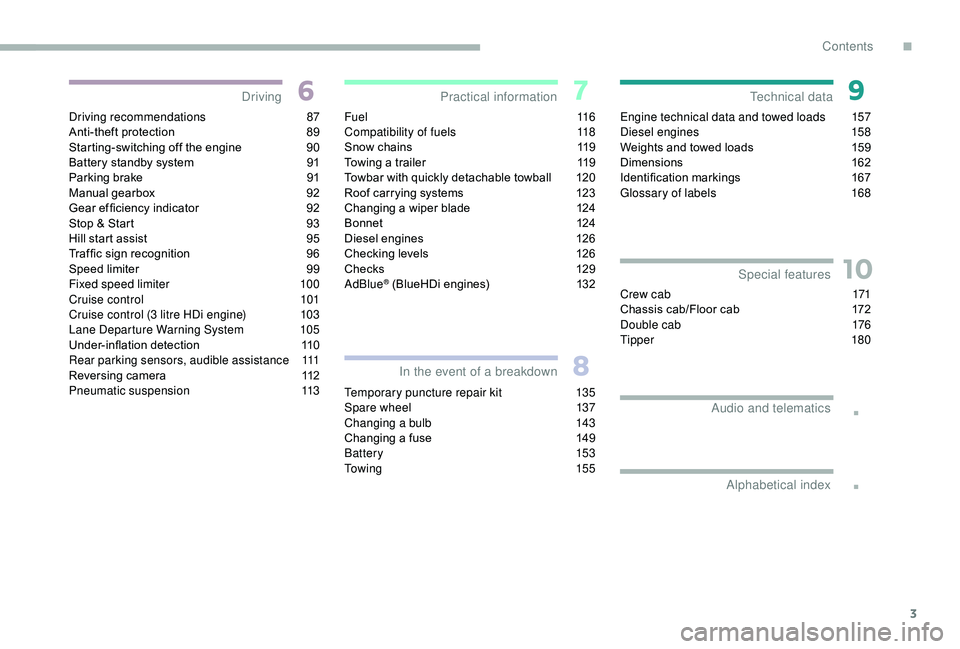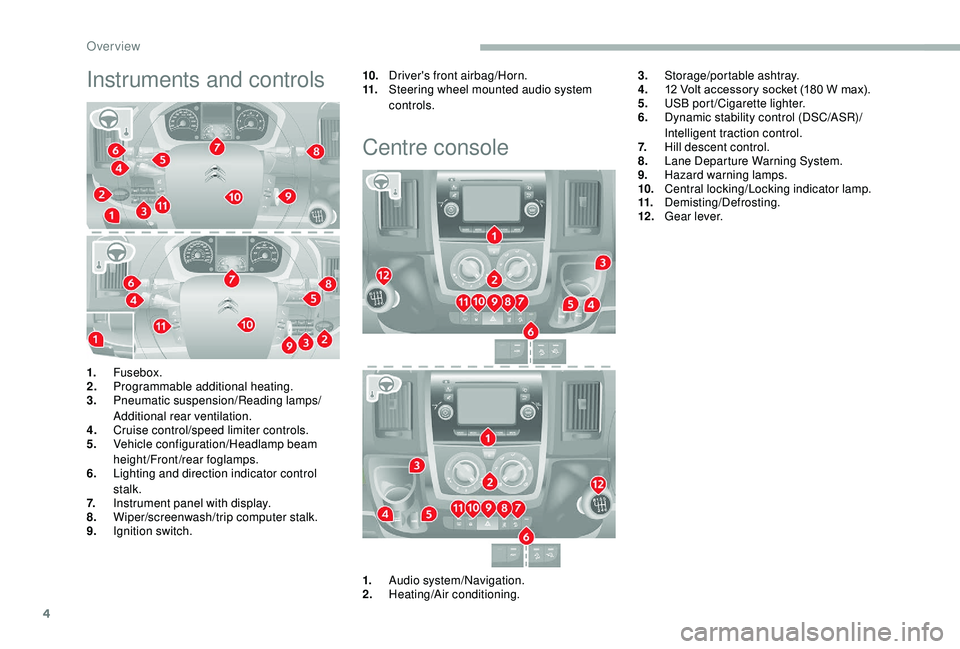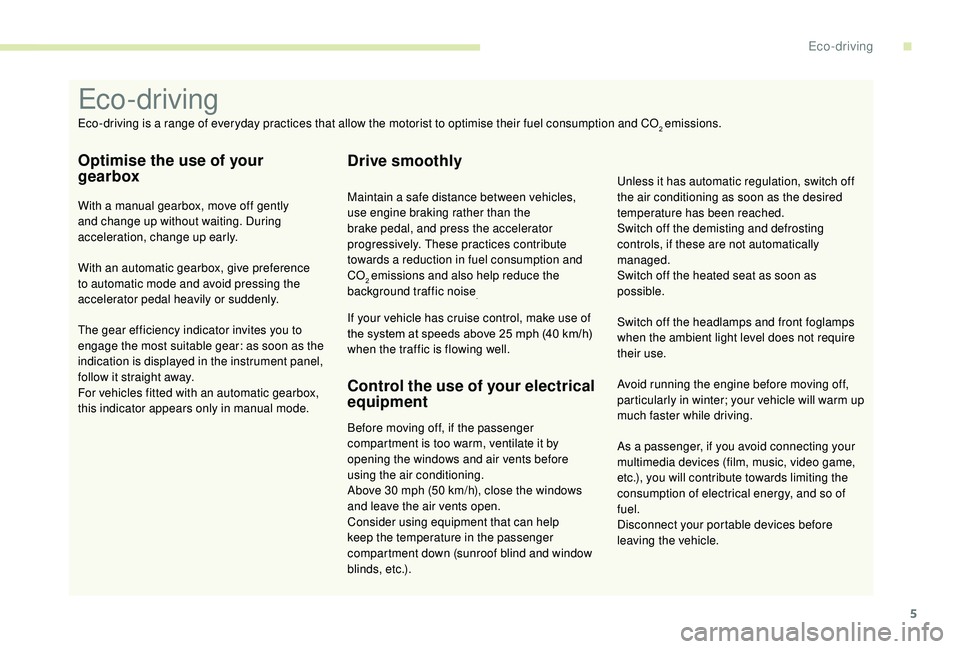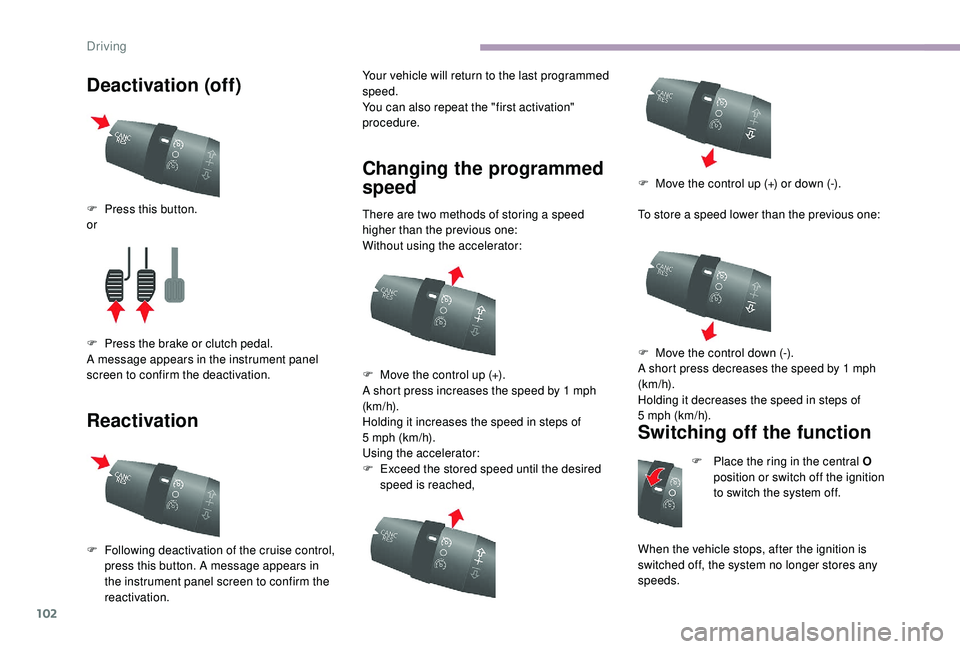cruise control CITROEN RELAY 2019 Handbook (in English)
[x] Cancel search | Manufacturer: CITROEN, Model Year: 2019, Model line: RELAY, Model: CITROEN RELAY 2019Pages: 232, PDF Size: 8.21 MB
Page 5 of 232

3
.
.
10
Driving recommendations 87
Anti-theft protection 8 9
Starting-switching off the engine
9
0
Battery standby system
9
1
Parking brake
9
1
Manual gearbox
9
2
Gear ef ficiency indicator
9
2
Stop & Start
9
3
Hill start assist
9
5
Traf fic sign recognition
9
6
Speed limiter
9
9
Fixed speed limiter
1
00
Cruise control
1
01
Cruise control (3
litre HDi engine)
1
03
Lane Departure Warning System
1
05
Under-inflation detection
1
10
Rear parking sensors, audible assistance
1
11
Reversing camera
1
12
Pneumatic suspension
1
13F u e l
11 6
Compatibility of fuels 1 18
Snow chains
1
19
Towing a
trailer
1
19
Towbar with quickly detachable towball
1
20
Roof carrying systems
1
23
Changing a
wiper blade
1
24
Bonnet
12
4
Diesel engines
1
26
Checking levels
1
26
Chec ks
12
9
AdBlue
® (BlueHDi engines) 1 32
Temporary puncture repair kit
1
35
Spare wheel
1
37
Changing a
bulb
1
43
Changing a
fuse
1
49
Battery
153
To w i n g
15 5Engine technical data and towed loads
1
57
Diesel engines
1
58
Weights and towed loads
1
59
Dimensions
1
62
Identification markings
1
67
Glossary of labels
1
68
Driving
Practical information
In the event of a breakdown Technical data
Alphabetical index Special features
Crew cab 1
71
Chassis cab/Floor cab 1 72
Double cab
1
76
Tipper
18
0
Audio and telematics
.
Contents
Page 6 of 232

4
Instruments and controls10.Driver's front airbag/Horn.
11. Steering wheel mounted audio system
controls.
Centre console
3.Storage/portable ashtray.
4. 12
Volt accessory socket (180 W max).
5. USB port/Cigarette lighter.
6. Dynamic stability control (DSC/ASR)/
Intelligent traction control.
7. Hill descent control.
8. Lane Departure Warning System.
9. Hazard warning lamps.
10. Central locking/Locking indicator lamp.
11. Demisting/Defrosting.
12 . Gear lever.
1. Fusebox.
2. Programmable additional heating.
3. Pneumatic suspension/Reading lamps/
Additional rear ventilation.
4. Cruise control/speed limiter controls.
5. Vehicle configuration/Headlamp beam
height/Front/rear foglamps.
6. Lighting and direction indicator control
stalk.
7. Instrument panel with display.
8. Wiper/screenwash/trip computer stalk.
9. Ignition switch.
1.Audio system/Navigation.
2. Heating/Air conditioning.
Over view
Page 7 of 232

5
As a passenger, if you avoid connecting your
m ultimedia devices (film, music, video game,
etc.), you will contribute towards limiting the
consumption of electrical energy, and so of
fuel.
Disconnect your portable devices before
leaving the vehicle.
Eco- driving
Eco-driving is a range of everyday practices that allow the motorist to optimise their fuel consumption and CO2 emissions.
Optimise the use of your
gearbox
With a manual gearbox, move off gently
an d change up without waiting. During
acceleration, change up early.
With an automatic gearbox, give preference
to automatic mode and avoid pressing the
accelerator pedal heavily or suddenly.
The gear efficiency indicator invites you to
engage the most suitable gear: as soon as the
indication is displayed in the instrument panel,
follow it straight away.
For vehicles fitted with an automatic gearbox,
this indicator appears only in manual mode.
Drive smoothly
Maintain a safe distance between vehicles,
u se engine braking rather than the
brake pedal, and press the accelerator
progressively. These practices contribute
towards a
reduction in fuel consumption and
CO
2 emissions and also help reduce the
background traffic noise
.
If your vehicle has cruise control, make use of
the system at speeds above 25 mph (40 km/h)
when the traffic is flowing well.
Control the use of your electrical
equipment
Before moving off, if the passenger
compartment is too warm, ventilate it by
opening the windows and air vents before
using the air conditioning.
Above 30
mph (50 km/h), close the windows
and leave the air vents open.
Consider using equipment that can help
keep the temperature in the passenger
compartment down (sunroof blind and window
blinds, etc.). Switch off the headlamps and front foglamps
when the ambient light level does not require
their use.
Avoid running the engine before moving off,
particularly in winter; your vehicle will warm up
much faster while driving. Unless it has automatic regulation, switch off
the air conditioning as soon as the desired
temperature has been reached.
Switch off the demisting and defrosting
controls, if these are not automatically
managed.
Switch off the heated seat as soon as
possible.
.
.
Eco-drivingsommaire
Page 18 of 232

16
Warning/indicator lampStateCause Actions/Comments
Cruise control Fixed. Cruise control is selected. Manual selection.
Dipped beam
headlamps Fixed.
A manual selection. Turn the lighting control stalk ring to the second
position.
Blue warning/indicator lamps Main beam
headlamps Fixed.
The lighting control stalk has
been pulled towards you. Pull the lever to return to dipped beam headlamps.
Automatic
headlamps Fixed.
This function is activated in the
"MODE" menu. Switching on and off of the main beam headlamps
is managed automatically depending on the driving
conditions and the traffic.
For more information on Vehicle configuration
, refer
to the corresponding section.
Temperature/Ice The ice warning
lamp, the temperature
flashing, accompanied
by a
message on
screen. Weather conditions which could
result in ice on the road.
Be particularly vigilant and do not brake sharply.
Date/Time Setting: the date, the
time. A configuration via the "MODE"
menu. For more information on Vehicle configuration
, refer
to the corresponding section.
Warning/indicator lamp in
the display screen
Displays
Indicates Actions/Comments
Dashboard instruments
Page 102 of 232

100
Activation/Deactivation
Exceeding the programmed
speed
F Press f irmly on the
accelerator pedal, going
beyond the point of
resistance , to exceed
the programmed speed
limit. On a
steep descent or in the event of
sharp acceleration, the speed limiter will
not be able to prevent the vehicle from
exceeding the programmed speed.
Switching off the function
F Place the ring in the central O position or switch off the ignition
to switch the system off.
The last programmed speed remains in the
memory.
Malfunction
Pressing the button for the first time activates
the speed limiter.
OFF disappears from the screen and
a
message appears to confirm activation.
A second press deactivates it, OFF reappears
in the screen and a
message appears to
confirm deactivation. The limiter is deactivated temporarily and the
programmed speed flashes.
To return to the limiter function, reduce your
speed below the programmed speed.
Fixed speed limiter
If your vehicle is so equipped, you can limit it to
a
fixed speed of 56 or 62 mph (90 or 100 km/h).
A label in the passenger compartment indicates
this maximum speed.
The fixed speed limiter is not a
function like
the cruise control. It cannot be activated or
deactivated by the driver while driving. The use of mats not approved by
CITROËN may inter fere with the operation
of the speed limiter.
To avoid any risk of jamming of the pedals:
-
e
nsure that the mat is positioned
c o r r e c t l y,
-
d
o not fit one mat on top of another.
The programmed speed is cleared then
replaced by dashes.
Have it checked by a
CITROËN dealer or by
a
qualified workshop.
Driving
Page 103 of 232

101
The maximum speed set in the factory
depends on the legislation in force in the
country of sale.
This maximum speed cannot be modified
by the driver.
If you want the maximum speed modified,
go to a CITROËN dealer.
Cruise control
In order for it to be programmed or activated,
the vehicle speed must be greater than 19 mph
(30
km/h) with 2nd gear or higher engaged.
1. Selecting the cruise control function.
2. Activation/deactivation of the function.
3. Programming a
speed. The status of the cruise control is given by an
indicator in the rev counter and messages in
the instrument panel screen.
Function selected.
Function deactivated.
Selecting the function
System which automatically
maintains the cruising speed of the
vehicle at a
setting programmed by
the driver, without any action on the
accelerator pedal.
First activation/
programming a
speed
F Reach the chosen speed by pressing the
accelerator. The vehicle will maintain this speed setting.
F
T
urn the ring fully upwards. The
cruise control is selected but is
not yet active and no speed has
been programmed.
The indicator comes on in the
instrument panel. F
M
ove the control up (+) or down (-) to store
the speed. A message appears in the
instrument panel screen to confirm the
activation.
The stored speed is visible in the instrument
panel display.
Temporarily exceeding the
speed
It is possible to accelerate
and drive momentarily at
a
speed faster than the
programmed speed.
When the accelerator pedal is released, the
vehicle will return to the programmed speed.
6
Driving
Page 104 of 232

102
Deactivation (off)
ReactivationYour vehicle will return to the last programmed
speed.
You can also repeat the "first activation"
procedure.
Changing the programmed
speed
There are two methods of storing a speed
h igher than the previous one:
Without using the accelerator:
Using the accelerator:
F
E
xceed the stored speed until the desired
speed is reached, To store a
speed lower than the previous one:
Switching off the function
F Place the ring in the central O
position or switch off the ignition
to switch the system off.
When the vehicle stops, after the ignition is
switched off, the system no longer stores any
speeds.
F
P
ress this button.
or
F
P
ress the brake or clutch pedal.
A message appears in the instrument panel
screen to confirm the deactivation.
F
F
ollowing deactivation of the cruise control,
press this button. A message appears in
the instrument panel screen to confirm the
reactivation. F
M
ove the control up (+).
A short press increases the speed by 1
mph
(km/h).
Holding it increases the speed in steps of
5
mph (km/h). F
M
ove the control up (+) or down (-).
F
M
ove the control down (-).
A short press decreases the speed by 1 mph
(km/h).
Holding it decreases the speed in steps of
5
mph (km/h).
Driving
Page 105 of 232

103
Malfunction
In the event of a fault, the system is
s witched off and the indicator goes
out.
Have it checked by a
CITROËN dealer or by
a
qualified workshop. Use the cruise control only when traffic
conditions allow you to travel at a
constant
speed for a
certain period of time whilst
keeping a
sufficiently safe distance from
other vehicles.
Do not activate the cruise control in urban
areas, in heavy traffic, on winding or steep
roads, on slippery or flooded roads, or in
conditions of poor visibility (heavy rain,
fog, falling snow, etc.).
In some circumstances, it may not
be possible to maintain or reach the
programmed speed: towing, vehicle
heavily loaded, steep climb, etc. The use of mats not approved by
CITROËN may impair the operation of the
cruise control.
To avoid any risk of jamming of the pedals:
-
e
nsure that the mat is positioned
c o r r e c t l y,
-
d
o not fit one mat on top of another.
Cruise control (3 litre HDi
e ngine)
System which automatically
maintains the cruising speed of the
vehicle at a
setting programmed by
the driver, without any action on the
accelerator pedal. 1.
Cruise control On/Off.
2. Programming a
speed.
3. Return to the programmed speed.
If your vehicle is fitted with cruise control, this
is displayed on the instrument panel by an
indicator located in the rev counter.
Function selected.
Function deactivated.
The cruise control system is a driving aid
only. It does not exempt the driver from
keeping to speed limits or the need to
remain vigilant at all times.
In order for it to be programmed or activated,
the vehicle speed must be greater than 19
mph
(30
km/h) with 2nd gear or higher engaged. As a
safety measure, you are advised to
keep your feet near the pedals at all times.
6
Driving
Page 106 of 232

104
Selecting the function – ON
Programming a
speedTemporarily exceeding the
speed
When the cruise control is active, it is still
possible to exceed the programmed speed by
depressing the accelerator pedal (to overtake
another vehicle for example).
Changing the programmed
speed while the cruise
control is in operation
Yo u c a n :
Switching off/deactivating
the functionSelecting ON
switches the function on. A
message appears in the instrument panel
screen to confirm the action.
F
A
ccelerate to the required speed, with 2nd
to 6th gear engaged.
F
M
ove the control upwards (+), for
approximately one second, to store this
speed.
F
R
elease the pressure on the accelerator
pedal, the vehicle will maintain this speed. The stored speed is visible in the instrument
panel display.
-
i
ncrease the speed in steps, by means of
brief presses, or continuously by pressing
and holding the up control (+ sign), -
d
ecrease the speed continuously by
pressing and holding the control downwards
(- sign).
F
P
ress the brake or clutch pedal or place the
ring in the OFF position, the indicator goes
of f.
If the dynamic stability control system comes
into operation, the cruise control system is
deactivated temporarily.
Driving
Page 107 of 232

105
Restore – RES
To restore the vehicle's programmed speed
(for example after pressing the brake or clutch
pedal):The indicator comes on and the
cruise control function is restored.
F
G
o back gradually to the selected speed
and press RES .
Cancelling the programmed
speed
When the vehicle stops, after the ignition is
switched off, the system no longer stores any
speeds.
Malfunction
In the event of a fault, the system is
s witched off and the indicator goes
out.
Have it checked by a
CITROËN dealer or by
a
qualified workshop. Use the cruise control only when traffic
conditions allow you to travel at a
constant
speed for a certain period of time whilst
keeping a sufficiently safe distance from
other vehicles.
Do not activate the cruise control in urban
areas, in heavy traffic, on winding or steep
roads, on slippery or flooded roads, or in
conditions of poor visibility (heavy rain,
fog, falling snow, etc.).
In some circumstances, it may not
be possible to maintain or reach the
programmed speed: towing, vehicle
heavily loaded, steep climb, etc.
The use of mats not approved by
CITROËN may impair the operation of the
cruise control.
To avoid any risk of jamming of the pedals:
-
e
nsure that the mat is positioned
c o r r e c t l y,
-
d
o not fit one mat on top of another.
Lane Departure Warning
System
System which detects the involuntary crossing
of longitudinal traffic lane markings on the
ground (solid or broken line).
The lane departure warning system
cannot, in any circumstances, replace the
need for vigilance on the part of the driver.
A camera fitted at the top centre of the
windscreen monitors the road and detects lane
markings and the position of the vehicle with
respect to them.
With the vehicle running at a
speed higher than
37
mph (60 km/h), it triggers a warning if the
vehicle drifts off line.
This system is particularly useful on motor ways
and main roads.
6
Driving